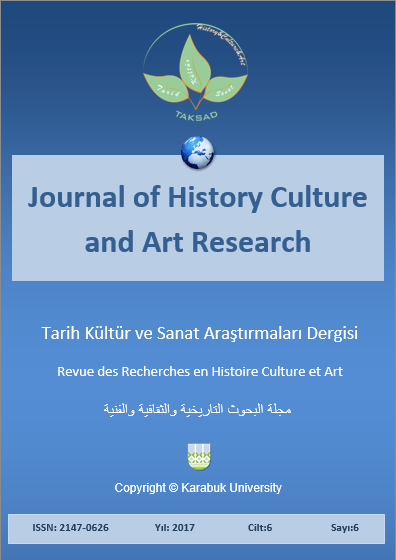Intertextual Links in the Context of the Problem of Folklore-Literary Relationships (with Reference to National Literature)
DOI:
https://doi.org/10.7596/taksad.v6i6.1339Anahtar Kelimeler:
Folklore- Literature- The problem of folklore-literary interrelations- The theory of intertextual relations- Allusions- citations.Özet
An attempts to apply the theory of intertextual analysis to the study of the ancient work of national literature, the Bashkir literature in particular, was made in the article. The folklore motifs used in the work mostly cause intertextual communication, an allusion to the poetic traditions of the Bashkir folklore, which are endowed with original artistic and aesthetic functions. In the frame of the article were considered the usage of the intertextual method in the study of the Turkic and Bashkir literatures, what gives a possibility to reveal the degree of correlation of works with the Eastern, Turkic-Bashkir literary and folklore traditions, to expand understanding of the semantics and poetics of literature, to define new ways of interpretation, to consider the literary heritage of the Bashkir people as an art system included in a single world context. The urgency of the work is beyond question, given that for the first time the work involves an attempt to combine traditional research methods with the theory of the intertextual analysis of a literary work.
Referanslar
Galimullin, F. G.; Galimullina, A. F. & Mingazova, L. I. (2014). The development of the literatures of the people of the Volga region in multi-ethnic Russia. Journal of Language and Literature, 5(3), 248-252. DOI: 10.7813/jll.2014/5-3/42.
Galimullin, F. G.; Galimullina, A. F. & Mingazova, L. I. (2016). Сommon roots, common spirituality: literary relationships of the tatar and Azerbaijani literature in the context of the dialogue of cultures. The Social Sciences.
Gimadieva, G. I.; Mingazova, L. I.; Sayilov, G. A. & Sayfulina, F. S. (2017). General Roots, General Spirituality: Literary Interrelations of Literatures in the Aspect of Cultural Dialogue. Journal of History Culture and Art Research, 6(4), 497-504.
Karabulatova, I. S.; Sayfulina, F. S. & Akhmetova, B. Z. (2013). Ethno-Lingual Aspect of Modern Functioning of Russian Dialects in North Kazakhstan (On an Example of Kostanai Region). World Applied Sciences Journal (Education, Law, Economics, Language and Communication), 27, 137-140.
Kul, G. (1985). The Legend of Yusuf. Transl. with Turkic. on rus. yaz. S. Ivanov. Kazan: Tatkhnigoizdat.
Medkova, E. S. (2017). Possibilities of pedagogical interpretation of the methodology of semiotics and structuralism in the teaching of the World Art Culture. URL: http://www.art-education.ru
Piege-Gros, N. (2007). Introduction to the theory of ittertextuality. Per. with French. G.K. Kosikova, V.Yu. Lukosik and others; Society. Ed. and entry. sl. G.Kosikova. URL: http://abuss.narod.ru/Biblio/piegegro.htm
Suleimanov, A. M. (2002). Our Kiss and Dastans. In N. Zaripov, A. Suleymanov, G. Khusainov (eds.), Bashkir folk art: Epos: Kiss and Dastans, Vol.6, (pp. 380-443). Ufa: Kitap.
Tomashevsky, B. V. (1960). Pushkin and France. London.
Trykova, O. Yu. (1999). Domestic prose of the last third of the twentieth century: genre interaction with folklore. Dissertation in Philology Science. Moscow.
İndir
Yayınlanmış
Nasıl Atıf Yapılır
Sayı
Bölüm
Lisans
Tarih Kültür ve Sanat Araştırmaları Dergisi'nde yayımlanan tüm çalışmalar Creative Commons 4.0 CC-BY lisansı ile lisanslanmıştır.
Bunları yapmakta özgürsünüz:
- Bu eseri her boyut ve formatta paylaşabilir — kopyalayabilir ve çoğaltabilirsiniz.
- Materyalden Adapte et — karıştır, aktar ve eserin üzerine inşa et
- her türlü amaç için, ticari amaç da dahil
Alttaki şartlar altında:
Atıf — uygun bilgiyi, lisansa linki, and ve değişiklik yapıldıysa değişiklik bilgisinivermelisiniz. Sizi veya kullanımınızı lisansörün onayladığı bilgisini içermemek kaydıyla, size uygun şekilde bu işlemleri gerçekleştirebilirsiniz.
AynıLisanslaPaylaş — Eğer materyali karıştırdınızsa, aktardınızsa ya da materyalin üzerine çalıştınızsa, ancak aynı lisans ile dağıtabilirsiniz.
- Ek sınırlamalar yoktur — Lisansın izin verdiği hakları başkaları üzerinde kanunlarla ya da teknolojiyikullanarak sınırlayamazsınız.







